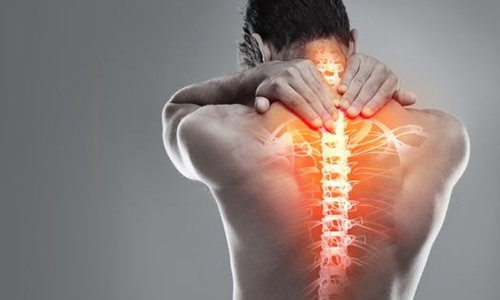Living with diabetes comes with its set of challenges, among which is an increased risk of experiencing back pain. This discomfort can stem from various diabetes-related complications, such as neuropathy, poor circulation, and other associated conditions. Understanding the connection between diabetes and back pain is the first step toward finding relief. This guide aims to explore effective diabetes back pain treatments and management strategies.
Contents
Can Diabetes Cause Severe Back Pain?
 Yes, diabetes can contribute to severe back pain in several ways, though it may not directly cause it. The connection between diabetes and back pain typically involves complications and conditions that are more common in individuals with diabetes. Here are some of the key factors linking diabetes to severe back pain:
Yes, diabetes can contribute to severe back pain in several ways, though it may not directly cause it. The connection between diabetes and back pain typically involves complications and conditions that are more common in individuals with diabetes. Here are some of the key factors linking diabetes to severe back pain:
- Neuropathy (Nerve Damage): One of the most common complications of diabetes is peripheral neuropathy. This often affects the feet and legs but can also cause pain in the back. Neuropathy can lead to pain, tingling, and numbness. And, resulting from damage to the nerves due to high blood sugar levels.
- Poor Circulation: Diabetes can affect blood flow, leading to poor circulation. This can result in slower healing times for injured tissues, including those in the back, potentially exacerbating pain and discomfort.
- Increased Risk of Infection: Individuals with diabetes may have an increased risk of infections, including those that can affect the spine (such as osteomyelitis or discitis). Infections in the spine can cause severe back pain and require prompt medical treatment.
- Musculoskeletal Changes: Diabetes can lead to changes in the musculoskeletal system, such as stiffening of the joints (diabetic stiff hand syndrome or cheiroarthropathy) and changes in the feet (Charcot foot). These changes can alter posture and gait, leading to increased strain on the back and potentially causing pain.
- Osteoporosis: There is some evidence to suggest that diabetes, especially type 1 diabetes, may be linked to a higher risk of osteoporosis. Osteoporosis weakens bones, making them more susceptible to fractures. It can occur in the spine and cause severe back pain.
It’s important for individuals with diabetes who experience back pain to consult with a healthcare provider to determine the exact cause of their pain and to receive appropriate treatment. Managing blood sugar levels effectively and addressing any diabetes-related complications can also help mitigate back pain.
How Do You Get Rid Of Back Pain From Diabetes?
Managing back pain stemming from diabetes involves addressing the root causes—such as nerve damage (neuropathy), circulation issues, and diabetes-related complications—alongside the pain itself. Here’s a multi-faceted approach to alleviating diabetes back pain:
Control Your Blood Sugar Levels
Effectively managing your blood sugar levels is foundational in preventing and reducing complications associated with diabetes. Consistently high blood sugar levels can damage nerves and blood vessels, exacerbating pain and discomfort in the back. Adhering to your diabetes management plan, which might include a combination of diet, exercise, and medication or insulin therapy, is essential.
Physical Therapy
A physical therapist can design a personalized exercise program that strengthens the muscles supporting your back, enhances flexibility, and improves posture. These exercises, when performed regularly, can significantly reduce the intensity and frequency of back pain episodes. Moreover, physical therapy can help address specific conditions like sciatica or lumbar issues. These are common in individuals with diabetes.
Exercise Regularly
Engaging in regular, low-impact physical activity is beneficial for both diabetes management and alleviating back pain. Activities such as walking, swimming, and practicing yoga not only improve blood flow and reduce blood sugar levels but also strengthen the core and back muscles, relieving pressure on the spine. Exercise induces the release of endorphins, the body’s natural painkillers, which can help reduce the perception of pain.
Medications
 For immediate back pain relief, over-the-counter pain relievers may be helpful. However, it’s critical to consult with your healthcare provider before using these medications, as some can interfere with blood sugar control. For neuropathic pain, a common issue in people with diabetes, doctors may prescribe medications that specifically target nerve pain, such as gabapentin or duloxetine. These can be effective in managing the pain without worsening diabetes symptoms.
For immediate back pain relief, over-the-counter pain relievers may be helpful. However, it’s critical to consult with your healthcare provider before using these medications, as some can interfere with blood sugar control. For neuropathic pain, a common issue in people with diabetes, doctors may prescribe medications that specifically target nerve pain, such as gabapentin or duloxetine. These can be effective in managing the pain without worsening diabetes symptoms.
Nutritional Support
A diet rich in nutrients that fight inflammation and support nerve health can be a powerful tool in managing diabetes-related back pain. Incorporating foods high in antioxidants (like berries, nuts, and leafy greens), omega-3 fatty acids (found in fish and flaxseeds), and magnesium (present in avocados, legumes, and whole grains) can help reduce inflammation and support overall spinal health. A balanced diet also supports diabetes management, contributing to better blood sugar control.
Weight Management
Excess body weight can increase the strain on your back, leading to pain and discomfort. By maintaining a healthy weight through a balanced diet and regular physical activity, you can reduce the pressure on your back muscles and spine. Weight loss can be particularly beneficial for individuals with type 2 diabetes, as it can improve insulin sensitivity, making diabetes easier to manage. This, in turn, can alleviate associated back pain.
Alternative Therapies
Alternative therapies such as acupuncture, massage therapy, and chiropractic care can offer supplementary relief from back pain. Acupuncture can help reduce pain by promoting the release of endorphins. Massage therapy can alleviate muscle tension and improve circulation, while chiropractic adjustments can improve spinal alignment and reduce nerve irritation. It’s important to choose practitioners who are experienced in treating individuals with diabetes.
Stress Management
Stress can not only worsen back pain but also negatively affect your diabetes control. Implementing stress management techniques like mindfulness, meditation, and deep breathing can help lessen the impact of stress on your body. Engaging in activities that relax both the mind and body, such as tai chi or gentle yoga, can also be beneficial in managing stress and reducing back pain.
Proper Footwear and Posture
 Wearing supportive footwear and maintaining good posture can have a significant impact on back pain. Shoes that provide proper arch support and cushioning can minimize stress on your back throughout the day. Additionally, being mindful of your posture, especially if you spend long periods sitting or standing, can prevent unnecessary strain on your back muscles and spine.
Wearing supportive footwear and maintaining good posture can have a significant impact on back pain. Shoes that provide proper arch support and cushioning can minimize stress on your back throughout the day. Additionally, being mindful of your posture, especially if you spend long periods sitting or standing, can prevent unnecessary strain on your back muscles and spine.
Regular Check-ups
Routine visits to your healthcare provider are essential for managing diabetes and its complications, including back pain. These check-ups allow for the monitoring of your diabetes control and the early detection and treatment of any diabetes-related complications that could contribute to back pain. Collaborating with a multidisciplinary team and possibly a diabetes educator, ensures a comprehensive approach to managing both your diabetes and back pain.
If back pain persists despite these measures or pain that radiates down your legs, it’s crucial to seek immediate medical attention. Because these could be signs of more serious conditions requiring prompt treatment.
What Are Some Medical Diabetes Back Pain Treatments?
 When addressing back pain specifically associated with diabetes, diabetes back pain treatments often focus on both managing the diabetes effectively and directly treating the symptoms of back pain. Here are some medical diabetes back pain treatments that may be considered:
When addressing back pain specifically associated with diabetes, diabetes back pain treatments often focus on both managing the diabetes effectively and directly treating the symptoms of back pain. Here are some medical diabetes back pain treatments that may be considered:
Medication for Blood Sugar Control
For individuals with diabetes, tightly managing blood sugar levels is crucial. Medications such as metformin, insulin, and various types of oral hypoglycemics play a significant role in controlling diabetes. And, by extension, may help mitigate conditions contributing to back pain.
Pain Medication
Over-the-counter (OTC) pain relievers, such as acetaminophen (Tylenol) or NSAIDs (nonsteroidal anti-inflammatory drugs like ibuprofen or naproxen), may be used to manage acute back pain episodes. For chronic or severe pain, stronger pain medications, including opioids, might be prescribed for short-term use under strict medical supervision to avoid dependency and manage side effects.
Antidepressants and Anticonvulsants
Certain antidepressants and anticonvulsants have been found effective in treating neuropathic pain—a common type of pain associated with diabetes due to nerve damage. Medications such as duloxetine (Cymbalta) and pregabalin (Lyrica) are often prescribed to reduce the symptoms of diabetic neuropathy, which can manifest as back pain among other discomforts.
Topical Treatments
Topical analgesics and capsaicin creams can be applied to the skin over the painful area. These treatments can provide temporary relief from pain by either inducing a warming sensation that distracts from the pain or by depleting substance P, a chemical involved in transmitting pain signals to the brain.
Surgery
Surgery is considered a last resort for back pain treatment and is typically reserved for cases where there is a clear anatomical problem that has not responded to other treatments, such as a herniated disc or spinal stenosis causing significant pain or neurological issues. The decision for surgery takes into account the overall health of the individual, including diabetes management.
TENS (Transcutaneous Electrical Nerve Stimulation)
A TENS unit delivers small electrical impulses through electrodes placed on the skin, which can help alleviate pain. The electrical currents can reduce pain signals going to the spinal cord and brain. Thus, potentially relieving back pain and stimulating endorphin release.
It’s important to approach diabetes back pain treatment comprehensively. An interdisciplinary team can offer a coordinated and effective treatment plan. This team approach ensures that treatments for back pain do not interfere with diabetes management and vice versa.
Conclusion
Concluding this blog through understanding and managing back pain in individuals with diabetes, it’s clear that a multifaceted approach is key. By diligently managing blood sugar levels, and incorporating a mix of medical treatments, physical therapy, and lifestyle modifications, individuals can significantly alleviate their diabetes back pain.
Remember, achieving relief from back pain is not only about treating the pain itself but also about nurturing overall health and well-being. Do you want to get rid of diabetes? Join our online diabetes treatment program and reverse Diabetes naturally through lifestyle changes such as a Personalized Diet plan, Exercise, Yoga, dieticians, and health coaches.

